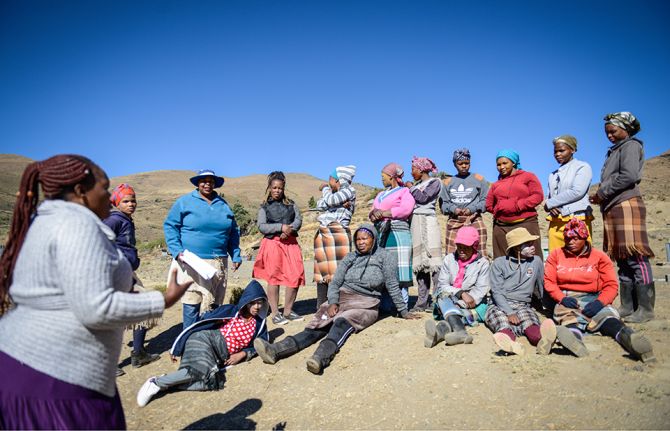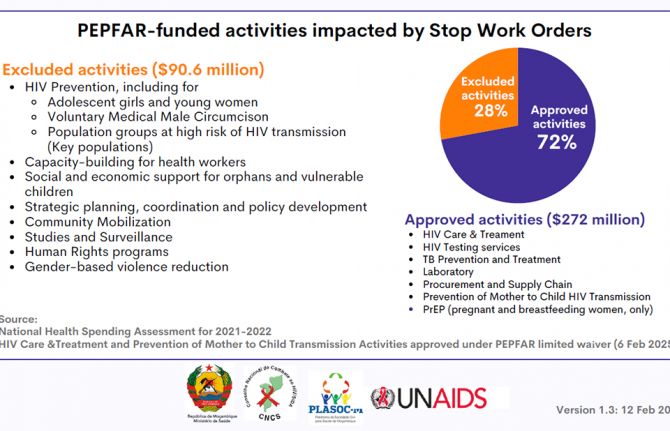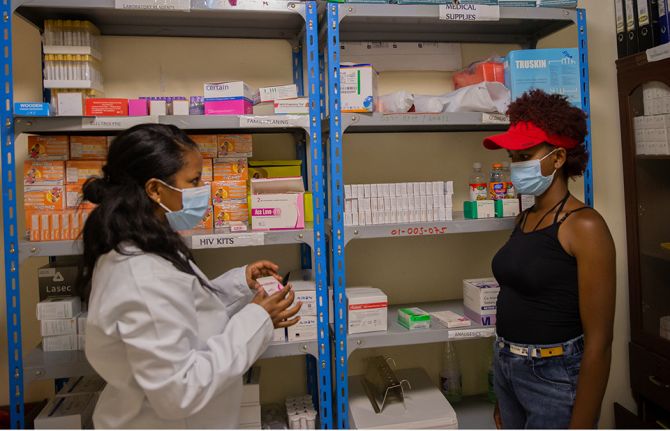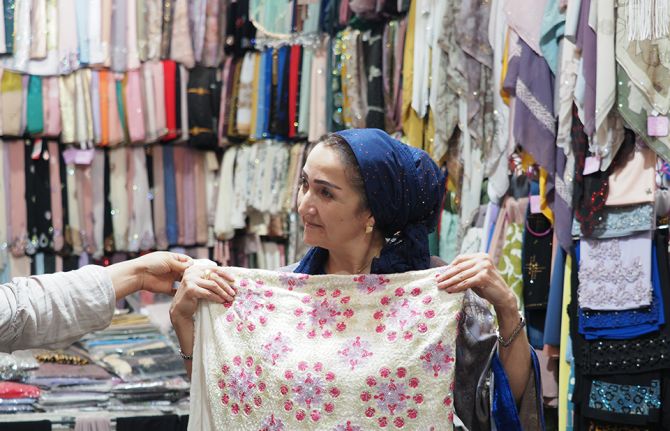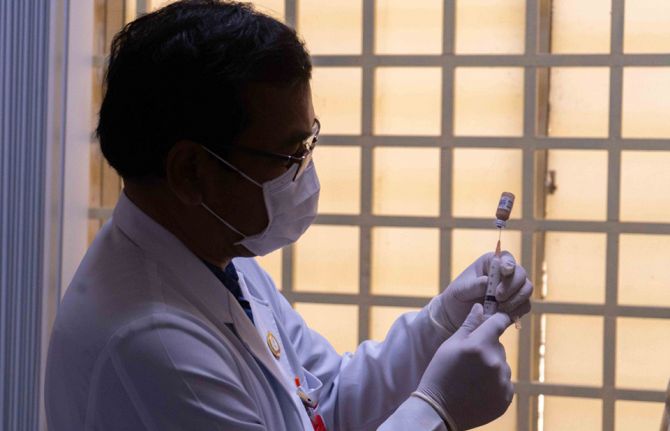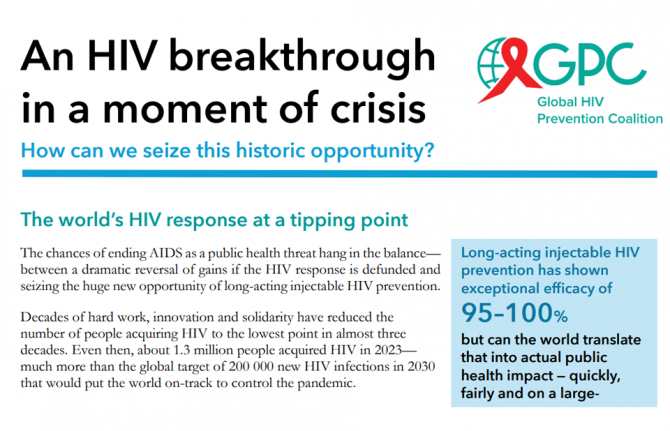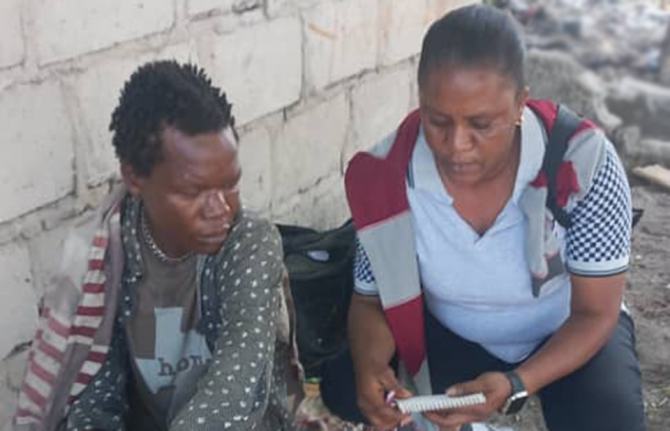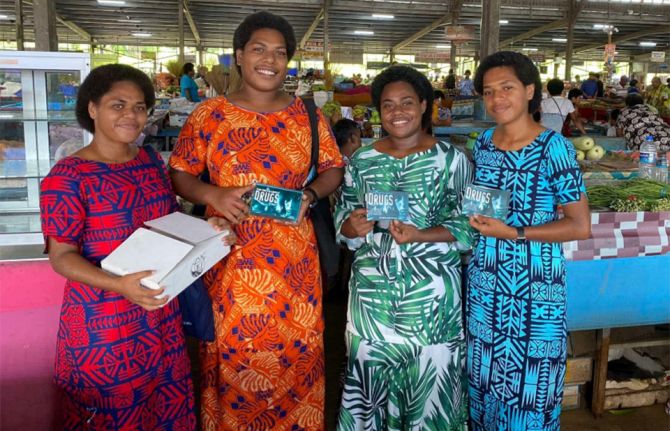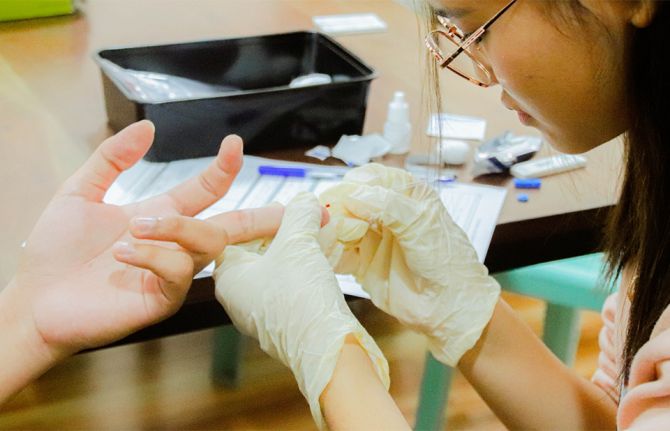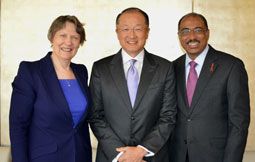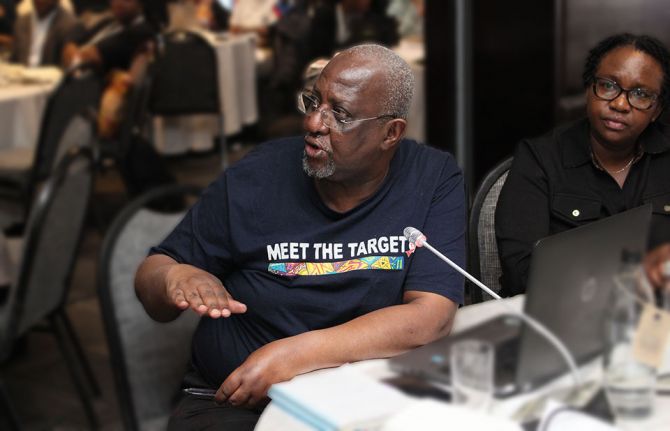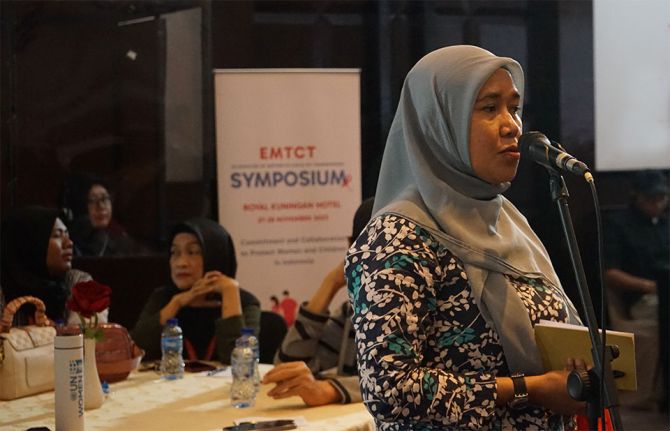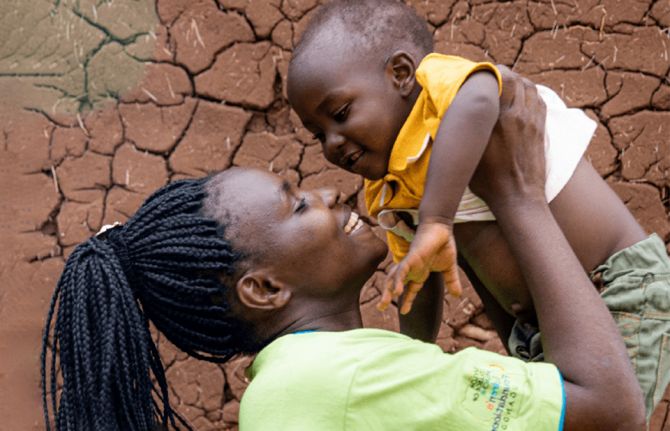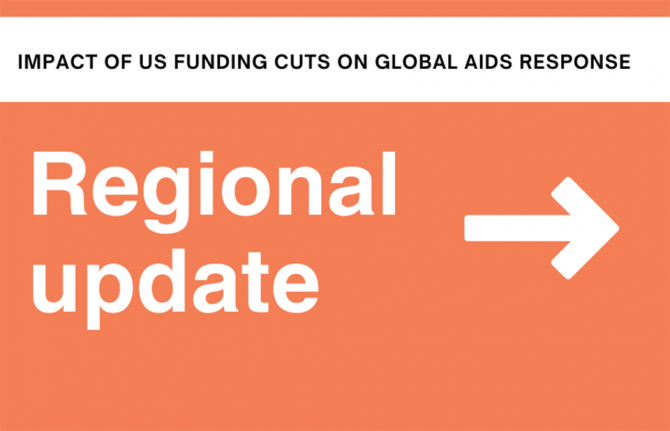
Feature Story
Kaiser Family Foundation and UNAIDS issue report on funding for AIDS by G8 countries and other major donors
13 July 2009
13 July 2009 13 July 2009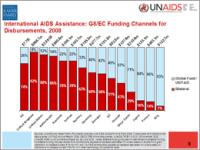
The Kaiser Family Foundation and the Joint United Nations Programme on HIV/AIDS (UNAIDS) have issued a new report on 2008 funding for global AIDS efforts from the Group of Eight nations, European Commission (EC) and other donor governments.
The latest annual report shows that overall commitments in AIDS funding from the developed world totalled US$ 8.7 billion in 2008, up from US$ 6.6 billion the previous year. Disbursements, which reflect actual resources made available in a given year and therefore provide a better measure of resource availability, rose even more rapidly, up 56 percent to reach US$ 7.7 billion in 2008.
Disbursements from the United States totaled US$ 4 billion in 2008, more than half of all disbursements and more than any other single country. The United Kingdom was the second largest donor, followed by the Netherlands, France, Germany, Norway and Sweden.
Financing a sufficient and sustained response to the AIDS epidemic in low- and middle-income countries has emerged as one of the world’s greatest health and development challenges. International assistance from donor governments, through bilateral aid and contributions to the Global Fund to Fight AIDS, Tuberculosis and Malaria, as well as other financing channels, is a critical part of the response. Importantly, while the report provides the latest data available on donor funding, it reflects budgets largely set in place before the acceleration of the current global economic crisis, which may create new challenges to future funding.
- Between 2002 and 2008, commitments and disbursements from developed nations each increased by more than five-fold.
- In 2008, donor governments disbursed US$ 5.7 billion bilaterally and earmarked funds for HIV through multilateral organizations, as well as an additional US$ 1.7 billion to combat HIV through the Global Fund to Fight AIDS, Tuberculosis and Malaria and US$ 265 million to UNITAID.
- When HIV disbursements are measured as a share of each nation’s gross domestic product, the Netherlands ranks first, followed by the United Kingdom, Ireland, and the United States.
Download the full report Financing the response to AIDS in low- and middle- income countries: International assistance from the G8, European Commission and other donor Governments in 2008 (pdf).
The Kaiser Family Foundation is a non-profit private operating foundation, based in Menlo Park, California, dedicated to producing and communicating the best possible analysis and information on health issues.
UNAIDS is an innovative joint venture of the United Nations, bringing together the efforts and resources of the UNAIDS Secretariat and ten UN system organizations in the AIDS response. The Secretariat headquarters is in Geneva, Switzerland—with staff on the ground in more than 80 countries. The Cosponsors include UNHCR, UNICEF, WFP, UNDP, UNFPA, UNODC, ILO, UNESCO, WHO and the World Bank. Contributing to achieving global commitments to universal access to comprehensive interventions for HIV prevention, treatment, care and support is the number one priority for UNAIDS.
Kaiser Family Foundation and UNAIDS issue report
Partners:
Feature stories:
Call for fully funded Global Fund to fight AIDS, Tuberculosis and Malaria (31 March 2009)
Economic crisis challenges UN health Goals (16 June 2009)
Top UN officials urge continued AIDS funding amid economic crisis (16 June 2009)
Paris Leading Group gathers to discuss financing development in times of crisis (28 May 2009)
Publications:

Feature Story
Morocco: Coming together to strengthen the AIDS response in the workplace
10 July 2009
10 July 2009 10 July 2009The world of work is a key arena for successfully challenging the AIDS epidemic, which affects the most economically active in every population. The majority of those living with the virus across the globe are workers. To promote this challenge in Morocco, the Ministry of Employment, in collaboration with the International Labour Organization (ILO) and UNAIDS, hosted a two-day national workshop on HIV workplace programmes in Casablanca at the end of June.
Bringing together actors from a number of sectors, the meeting included representatives from trade unions, government ministries, employers and businesses, NGOs, people living with HIV, medical officers and experts. It is the first of this scale and reach to be held and over 60 discussion topics were explored.
The initiative of developing a sectoral plan on HIV workplace programmes by the Ministry of Employment makes Morocco a pioneer country among other low prevalence countries.
Dr Moucharafou Idohou, ILO/AIDS National Project Coordinator
The main aim of the workshop was to progress towards the development of a strategic AIDS plan. This three-pronged plan would include: HIV prevention in the workplace; care and support for people living with the virus and tacking stigma and discrimination; and management and coordination of the challenge to AIDS.
In order to arrive at this goal, the first day of the meeting was devoted to exploring the country's AIDS response in the world of work to date, which included a high-level discussion on challenges and lessons learned in developing HIV programmes in this sector. The principles and guidelines of the ILO, with emphasis on its Code of Practice on HIV and the world of work, adopted in 2001, were also examined.
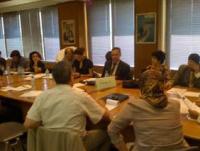
It was noted that a great deal of good work had already been achieved by a number of individuals and organizations, including the Association Marocaine de Lutte contre le Sida (Moroccan Association for the Fight against AIDS - ALCS), AIDS Entreprises Morocco (a national network of companies working on HIV and STI programmes in the workplace), as well as trade unions and occupational physicians. However, all still face a number of constraints in integrating the AIDS response into the world of work.
Dr Moucharafou Idohou, the ILO National Project Coordinator in Benin, attended the Conference to present core ILO policy tools and share experience of workplace action in Francophone West Africa. He said he was pleased at progress made so far. "I congratulate the Moroccan authorities on their commitment to the AIDS response on the basis of a multi-sectoral approach and for including the workplace in this response. The initiative of developing a sectoral plan on HIV workplace programmes by the Ministry of Employment makes Morocco a pioneer country among other low prevalence countries."
The challenge to AIDS in the workplace is a key opportunity on the road to achieving universal access. We must pay special attention to the workers who are most at risk in terms of HIV infection and to the informal sector.
Dr Kamal Alami, UNAIDS Country Coordinator for Morocco
While working towards the development of the strategic plan, participants took a number of areas into consideration. They debated how to move towards implementing a programme aimed at the most vulnerable, i.e. informal and mobile workers.
Also necessary would be strengthening the capacity of employers’ organizations, unions and other business institutions, while mobilizing their resources for HIV prevention and education activities and challenging stigma and discrimination. How to continue raising awareness of the human rights aspect of HIV and its impact on companies, and setting a legal framework which could serve as a basis for national AIDS programmes responding to HIV in the world of work, were also discussed.
There were a number of conclusions emerging from the workshop. The delegates recommended:
- Setting up a national committee to focus on HIV in the workplace with representation from employers, unions and the government;
- Development of advocacy activities to sensitize social partners;
- Adapting the legislative framework to ensure good HIV programmes in the . workplace;
- More research on most at risk groups;
- Mobilization of national and international funding to implement the strategic AIDS plan.
The government of Morocco, through the Ministry of Employment, reiterated its commitment and willingness to work with its partners to effectively implement a national plan to respond to HIV and STIs in the workplace.
According to UNAIDS Country Coordinator for Morocco, Dr Kamal Alami, “The challenge to AIDS in the workplace is a key opportunity on the road to achieving universal access. We must pay special attention to the workers who are most at risk in terms of HIV infection and to the informal sector."
Morocco: Coming together to strengthen the AIDS r
Cosponsors:
Feature stories:
International Labour Conference tackles HIV in the world of work (03 June 2009)
Migrant workers and HIV vulnerability in South Asian and South East Asian countries (18 May 2009)
International labour standard would strengthen the HIV response in the workplace (21 July 2008)
ILO sees significant improvement in workplace attitudes to HIV (25 April 2008)
Health workforce crisis limits AIDS response (29 February 2008)
Publications:
Health workforce crisis limits AIDS response 29 February 2008 (pdf, 863.1 Kb.)
Employers' handbook on HIV/AIDS: a guide for action (pdf, 609 Kb.)
ILO Code of Practice on HIV/AIDS and the world of work
Related

Feature Story
All-Russian Union of People Living with HIV
09 July 2009
09 July 2009 09 July 2009 More than 200 participants from 54 regions of Russia discussed the strategic development of the All- Russian Union of People Living with HIV for the next two years during its first conference in June 2009.
More than 200 participants from 54 regions of Russia discussed the strategic development of the All- Russian Union of People Living with HIV for the next two years during its first conference in June 2009. Credit: UNAIDS
The official registration of the All-Russian Union of People Living with HIV has become a major breakthrough in the national response to AIDS in the Russian Federation. The All-Russian Union was officially registered in May 2009 and had its first conference in June 2009 under the theme “All –Russian Union of People Living with HIV: Actual Issues of Development”.
The organization has gone a long way from the first meeting in 1998 when a few people living with HIV and representatives of different public organizations gathered together and realized the need to join their efforts for a more effective work in the AIDS response. It was not an easy process to work out the mission and agree on the principles of joint work and organizational structure. Discussions, debates, fights, and reconciliations were happening parallel to real day to day work in different NGOs active in the AIDS response.
Now, the organization unites people from 50 regions of Russia. It’s based on a district principle which ensures democracy and representation in the framework of the network and consolidation of participants’ efforts.
“Our organizational mission is this: we, people living with HIV join our potential and efforts to improve the quality of life of every person affected by HIV in Russia, says Vladimir Mayanovsky, the Chairman of Coordination Council of All-Russian Union of People Living with HIV. Our organization provides an excellent opportunity to improve the involvement of people living with HIV in the national AIDS response and contribute to fight HIV at federal and regional level. We are qualified and equipped with different knowledge and skills to become the real leaders in the civil society’s response to the epidemic”.
Members of All Russian Union of People Living with HIV are active in providing prevention programmes, self support groups, palliative care, organizing special advocacy events and working with most at risk population groups. The members are divided in subcommittees which focus on different thematic areas. These subcommittees provide consultation services to thousands of people living with HIV in Russia.
The All- Russian Union of People Living with HIV has strong leadership, transparent structure, partners in government and civil society. The organization has a huge potential. We consider it as one of our leading partners in civil society in strengthening HIV responses at national level.
Dr. Marina Semenchenko,
UNAIDS Team Leader a.i. in Russia
Members of the Union also advocate to addressing urgent issues such as the lack of confidentiality for children living with HIV in primary school care and medical institutions or the law that does not allow people living with HIV to adopt children. Members of All –Russian Union of People Living with HIV cooperate with penitentiary system and provide social support to people released from prisons.
Local branches of the Union have also initiated new projects in their areas. For example, one branch in Dagestan introduced a special educational course on HIV prevention at Dagestan Social University which is being implemented by one of the members of the Union. The branch in Volgograd opened a hotline that provides quality information on AIDS issues. The branch in Khanty-Mansiysk federal region, which is one of the regions most affected by HIV in Russia, provides assistance in accessing antiretroviral treatment to those in need. In Siberia another union member initiated HIV testing in remote areas by inviting medical professionals from regional AIDS Centers to go there.
Dr.Larisa Dementyeva, a representative from the Department on HIV/AIDS of the Russian Federal Service of Surveillance Over Consumer Rights Protection and Human Well-Being welcomed the All-Russian conference of People Living with HIV in Russia.
“Members of All Russian Union People Living with HIV are knowledgeable and enthusiastic young people, said Dr. Dementyeva. We consider the Union as our partner in meeting the needs of people living with HIV. The Union plays a very significant role in raising awareness about HIV prevention, reducing stigma and promoting tolerance.”
More than 200 participants from 54 regions of Russia discussed the strategic development of the All- Russian Union of People Living with HIV for the next two years and adopted the resolution of the meeting.
“The All- Russian Union of People Living with HIV has strong leadership, transparent structure, partners in government and civil society. The organization has a huge potential. We consider it as one of our leading partners in civil society in strengthening HIV responses at national level”, said Dr. Marina Semenchenko, UNAIDS Team Leader a.i. in Russia.
All-Russian Union of People Living with HIV
Feature stories:
Consultation on HIV prevention in the Russian Federation (10 March 2009)
Minister of Foreign Affairs of the Russian Federation discusses financial crisis with UN agencies (09 March 2009)
EECA AIDS conference co-chairs meet (06 March 2009)
Publications:
Policy Brief The Greater Involvement of People Living with HIV (GIPA) (pdf, 245 Kb)
A Nongovernmental Organization’s National Response to HIV: the Work of the All-Ukrainian Network of People Living with HIV (pdf, 849 Kb)
A Guide to PLHIV Involvement in Country Coordinating Mechanisms (GNP+) (pdf, 1.31 Mb)
Related

Feature Story
US First Lady Michelle Obama visits UNDP projects in Moscow
08 July 2009
08 July 2009 08 July 2009 Michelle Obama visited the St. Dimitry Sisterhood Medical Nurses College in Moscow.
Michelle Obama visited the St. Dimitry Sisterhood Medical Nurses College in Moscow.Credit: UNDP/Andrei Radkevich
US First Lady Michelle Obama visited St. Dimitry Sisterhood Medical Nurses College in Moscow, a nursing school that cares for people living with HIV on 7 July. While there, she stressed the need for more information and education to reduce stigma and raise awareness about how to care for people living with HIV. Ms. Obama, who worked previously as an executive for University of Chicago Hospitals, also shared her experience in the health care field and noted the importance of the work.
Created in 1992, the college trains nurses to care for people living with HIV as part of a larger UNDP project funded by USAID. St. Dimitry Sisterhood and Medical Nurses College aims to contribute to the decrease in HIV and AIDS incidence in the Russian Federation and mitigate the impact of the epidemic on the population by involving the Russian Orthodox Church in the prevention of the spread of the epidemic, reduction of stigma and discrimination, and provision of care and support to people living with HIV and affected by AIDS.
Sister Olga, project coordinator, emphasized that many more people, including youth and children, need this kind of support. “Our sisters are helping families with HIV-positive members as well as HIV-positive children living in orphanages,” she said.
UNDP works to prevent the spread of HIV and reduce the impact of AIDS. As a trusted development partner, and cosponsor of UNAIDS, it helps countries put HIV at the centre of national development and poverty reduction strategies; build national capacity to mobilize all levels of government and civil society for a coordinated and effective response to the epidemic; and protect the rights of people living with HIV, women, and vulnerable populations. Because HIV is a worldwide issue, UNDP supports these national efforts by offering knowledge, resources and best practices from around the world.
For more information, visit hivrussia.ru (in Russian) and the UNDP Russia Web site.
US First Lady Michelle Obama visits UNDP projects
Cosponsors:
Partners:
Feature stories:
Consultation on HIV prevention in the Russian Federation (10 march 2009)
Hidden HIV epidemic amongst MSM in Eastern Europe and Central Asia (26 January 2009)
“Artists Against AIDS” help fight stigma and discrimination in Russia (17 November 2008)
Related

Feature Story
International post office network to share HIV prevention messages
07 July 2009
07 July 2009 07 July 2009A version of this story was written by Faryal Mirza, Universal Postal Union (UPU)
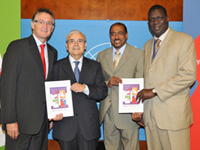
(Left to right) Mr Philip J. Jennings, General Secretary of UNI Global Union, Mr Edouard Dayan, Director General of the Universal Postal Union, Mr Michel Sidibé, Executive Director of UNAIDS and Mr Assane Diop, Executive Director of the Social Protection Sector at ILO during a press conference to launch the Global prevention awareness campaign at the Palais des Nations in Geneva, Switzerland on 7 July 2009.
Credit: UNAIDS/O. O'Hanlon
Halting the spread of HIV by 2015 is one of the United Nations Millennium Development Goals (MDGs). To contribute towards this goal, the Universal Postal Union (UPU) and UNAIDS together with the International Labour Organization (ILO) and UNI Global have launched a global awareness campaign. Post offices in participating countries will display HIV prevention information which will reach the general public and postal employees.
This awareness-raising campaign is part of the UPU’s ongoing effort to promote sustainable development and social responsibility among postal operators.
Edouard Dayan, UPU Director General
“This awareness-raising campaign is part of the UPU’s ongoing effort to promote sustainable development and social responsibility among postal operators,” says UPU Director General Edouard Dayan.
Global reach
In many parts of the world, post offices already have a social role by promoting public health messages within their community. At the heart of the campaign is the Posts’ unrivalled physical network of 660,000 post offices. Alison Phillips-Pearce, the UNAIDS campaign coordinator, is excited by the “enormous outreach” of the joint initiative. Also, the network has a special characteristic. “The Post is a place that is open to everyone from the young to the old and does not discriminate,” Phillips-Pearce adds.
Claude Montellier, head of the sustainable development programme at the UPU, believes there is the potential for Post Offices to do much outreach given that they already provide universal access to information. He added that this led the UPU to consider ways the postal network could benefit the public at large.
“Promoting social responsibility takes place through the development of awareness programmes about diseases for postal staff and the public,” he said.
UNAIDS created the bold advocacy materials for this campaign, including posters, postcards and country fact sheets.
Consultative process
For UNAIDS’ part, Phillips-Pearce shed light on why the campaign materials had taken their chosen form. “The materials were the outcome of a consultative process with our partners.” The materials were tested on a global audience and across genders to find out if the message was clear. The end result was the slogan: “Your post office cares. Protect yourself.”

“An adaptable slogan was needed to ensure that the message was meaningful to the country it is displayed in,” Phillips-Pearce said. In Brazil, for example, a more direct message was required, so the slogan on campaign materials there will read: “Your post office cares. Protect yourself. Wear a condom.”
First phase: Brazil, Burkina Faso, Cameroon, China, Estonia, Mali and Nigeria
As a first phase the campaign will reach out to postal customers of seven countries— Brazil, Burkina Faso, Cameroon, China, Estonia, Mali and Nigeria. These were chosen because of their HIV prevalence rates and to give a broad geographical spread. Estonia, for example, has Europe’s highest rate of HIV infection. During this initial phase, nearly 24,000 post offices will display and distribute the information materials and more UPU member countries will join later this year.
The campaign’s second phase in 2010 will focus on postal employees with help from the ILO and UNI Global Union. The ILO will prepare a toolkit for postal employers to use to inform their staff about HIV and UNI Global hopes to have the support of both the Posts and the workers’ unions for this phase.
Thirdly, in 2011, the UPU plans to invite its member countries to issue a stamp to commemorate the discovery of AIDS in 1981 when the first scientific article related to this disease was published.
“AIDS touch the lives of a very large part of our population”
Meanwhile, with the launch of the campaign the Cameroon Post is hoping that its 220 outlets will make an impact in the country where around five per cent of adults between 15 and 49 are living with HIV.
It is the first time that Mireille Ndancha Njilla, a postal operator, has participated in a health campaign, however she believes that there is a need to raise awareness of the virus in her community, as “HIV and AIDS touch the lives of a very large part of our population.”
International post office network to share HIV pr
Cosponsors:
International Labour Organization (ILO)
Partners:
Universal Postal Union (UPU)
UNI Global Union
Press centre:
UNAIDS, Universal Postal Union, UNI Global Union and ILO launch global HIV prevention campaign (07 July 2009)
Multimedia:
View photo gallery of campaign launch
Tools:
Prevent HIV: Fast facts
( en | ar | ch | es | fr | pt | ru | est )
Post Network Campaign Phase 1 Countries: Fact sheets
( en | es | fr | ru )
Post Network awareness campaign posters
( en | ar | ch | es | fr | pt | ru | est )

Feature Story
Landmark Delhi High Court decision recognizes inappropriate criminalization as a barrier to health, human rights and dignity
07 July 2009
07 July 2009 07 July 2009
According to Justices Shah and Muralidhar, the Constitution of India recognizes, protects and celebrates diversity.
The Delhi High Court declared section 377 of the Indian Penal Code which criminalised consensual sexual acts of adults in private as violative of the rights to privacy, liberty, health and equality enshrined in the Constitution of India. Though the decision was largely seen as a victory for the men who sex with men and transgender people, it is a victory for all – regardless of sexual orientation and gender identity. The judgment is noteworthy and progressive in terms of its rejection of a hetero-normative and homogenous conception of sexuality. According to Justices Shah and Muralidhar, the Constitution of India recognizes, protects and celebrates diversity.
Justice Edwin Cameron of South Africa’s Constitutional Court speaking at a meeting of men who have sex with men in Kathmandu, Nepal said, “Admittance of gays and lesbians is the ultimate measure of a society’s capacity to view humanity in its fullness and of its commitment to equality, justice, secularism, and humane co-existence.” This judgement has propelled India’s AIDS response and human rights movement a giant leap forward in this direction.
The Delhi High Court has restored the dignity and human rights of millions of men who have sex with men and transgendered people in India. Oppressive laws such as Section 377, drive people underground making it much harder to reach them with HIV prevention, treatment and care services.
Michel Sidibé, UNAIDS Executive Director.
"The Delhi High Court has restored the dignity and human rights of millions of men who have sex with men and transgendered people in India,” said UNAIDS Executive Director Mr Michel Sidibé. “Oppressive laws such as Section 377, drive people underground making it much harder to reach them with HIV prevention, treatment and care services.”
Justices Shah and Muralidhar’s judgment is evidence informed and grounded in human rights drawing its argument from case law from India and around the world, international declarations and commitments, scientific studies and UNAIDS policies.
In its affidavit before the judges, India’s National AIDS Control Organization (NACO), taking a opposite stand from that of the interior ministry contended that section 377 has hampered HIV prevention efforts. NACO cited that only 6% of all men who have sex with men have access to HIV prevention, treatment, care and support services, as most of them are reluctant to reveal their same sex behaviour due to fear of extortion, harassment, and violence at the hands of law enforcement authorities. It was noted that section 377 encourages people to remain hidden - making it difficult for them to access essential HIV, health and social services.
According to Jeffrey O’Malley, Director of UNDP’s HIV Practice, “Inappropriate criminalization is a major impediment to achieving universal access. This landmark judgment emphasizes the importance of improving the human rights situation for men who have sex with men and transgender people across the globe. We hope that other countries will follow suit. The realization of human rights for all is not only fundamental to our common humanity, it also is imperative for an effective AIDS response and generating broader health and development benefits.”
The realization of human rights for all is not only fundamental to our common humanity, it also is imperative for an effective AIDS response and generating broader health and development benefits.
Jeffrey O’Malley, Director of UNDP’s HIV Practice.
According to Justices Shah and Muralidhar, the criminalization of homosexuality condemns in perpetuity a sizable section of society and forces them to live their lives in shadow of harassment, exploitation, humiliation, cruel and degrading treatment at the hands of the law enforcement machinery. The judges referred to Article 12 of the Universal Declaration of Human Rights which states, "No one shall be subjected to arbitrary interference with his privacy, family, home or correspondence nor to attacks upon his honour and reputation. Everyone has the right to the protection of the law against such interference or attacks."
The judges concluded that to stigmatize or to criminalize homosexual only on account of their sexual orientation would be against constitutional morality. The judgment held that morality cannot be held as a ground for restriction of fundamental human rights. Justices Shah and Muralidhar concluded that “while it could be “a compelling state interest” to regulate by law, the area for the protection of children and others incapable of giving a valid consent or the area of non-consensual sex, enforcement of public morality does not amount to a “compelling state interest” to justify invasion of the zone of privacy of adult homosexuals engaged in consensual sex in private without intending to cause harm to each other or others.” The judges quoted a leading Indian luminary, Justice Krishna Iyer who said, “... The compulsion of constitutional humanism and the assumption of full faith in life and liberty cannot be so futile or fragmentary that any transient legislative majority in tantrums against any minority by three quick readings of a Bill with the requisite quorum, can prescribe any unreasonable modality and thereby sterilise the grandiloquent mandate.”
In their conclusion, the judges drew from one of the key principles of the Indian Constitution—inclusiveness. “If there is one constitutional tenet that can be said to be underlying theme of the Indian Constitution, it is that of 'inclusiveness'. This Court believes that Indian Constitution reflects this value deeply ingrained in Indian society, nurtured over several generations. The inclusiveness that Indian society traditionally displayed, literally in every aspect of life, is manifest in recognising a role in society for everyone. Those perceived by the majority as “deviants' or 'different' are not on that score excluded or ostracised. Where society can display inclusiveness and understanding, such persons can be assured of a life of dignity and nondiscrimination. Justices Shah and Muralidhar held that Indian “constitutional law does not permit the statutory criminal law to be held captive by the popular misconceptions of who the lesbians, gay, bisexuals, and transgender people are. It cannot be forgotten that discrimination is antithesis of equality and that it is the recognition of equality which will foster the dignity of every individual.”
In the 2006 United Nations Political Declaration on HIV/AIDS, governments committed to removing legal barriers and passing laws to protect vulnerable populations. Evidence shows that countries which have laws to protect men who have sex with men, injecting drug users and sex workers have provided better access to HIV prevention, treatment, care and support. UNAIDS along with UNDP, the lead Cosponsor, focusing on expanding and strengthening policies and programmes for men who have sex with men, transgender people and HIV, will support countries in removing laws that block effective AIDS response and increasing access to HIV prevention, treatment, care and support.
UNAIDS urges all governments to ensure full respect for the human rights of men who have sex with men, lesbians and transgender people through repealing laws that prohibit sexual acts between consenting adults in private; enforcing laws to protect these groups from violence and discrimination; promoting campaigns that address homophobia, transphobia and stigma, and ensuring that essential health and social services and support are available and accessible.
Landmark Delhi High Court decision recognizes ina
Feature stories:
International Day against Homophobia (15 May 2009)
Hidden HIV epidemic amongst MSM in Eastern Europe and Central Asia (26 January 2009)
China to tackle HIV indidence amongst MSM (16 January 2009)
HIV prevention hampered by homophobia (13 January 2009)
ICASA 2008: Men who have sex with men and HIV in Africa (07 December 2008)
Press centre:
UNAIDS welcomes historic decision by Delhi High Court to annul the law that criminalizes adult homosexual relations (pdf, 26.4 Kb.)
Read High-Court Judgment (pdf, 431 Kb)
AIDS responses failing men who have sex with men and transgender populations (15 May 2009)
Statement by Mr Michel Sidibé, Executive Director of UNAIDS, on occasion of the International Day Against Homophobia, 17 May, (15 May 2009)
UNAIDS expresses concern over decision by Burundian National Assembly to criminalize same sex relations (27 Apr 2009)
UNAIDS welcomes the release of nine men in Senegal imprisoned for their sexual orientation (20 Apr 2009)
UNAIDS and broad coalition working towards the release of nine men who have sex with men in Senegal who have been convicted and imprisoned (15 January 2009)
Criminalization of sexual behavior and transmission of HIV hampering AIDS responses (27 November 2008)
Multimedia:
![]() UNAIDS delivers a strong message at the 23 TEDDY Award in Berlin
UNAIDS delivers a strong message at the 23 TEDDY Award in Berlin
Publications:
UNAIDS Action Framework on Universal Access for Men who have Sex with Men and Transgender People (pdf, 274 Kb.)
Joint action for results: UNAIDS outcome framework, 2009 – 2011

Feature Story
Global economic crisis and HIV
06 July 2009
06 July 2009 06 July 2009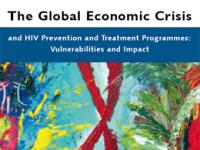
A joint Word Bank/UNAIDS report looks at the potential impact of the global financial crisis on HIV prevention and treatment programmes worldwide. Using data collected in March 2009 from 71 countries, the analysis looks at how the crisis could affect the nearly 4 million people living with HIV on treatment, and the 7 million who need treatment but don’t have access to it, and proposes some appropriate responses. The potential effects on prevention activities were also investigated. The report suggests that the well-being of millions of people could be put at risk.
The financial crisis started in the most-developed economies, but its impact has been felt in virtually all nations, leading to fears that donor assistance will remain flat or be cut, the budgetary revenues of developing countries will fall and worker remittances will decline. Many households may experience increased mortality and morbidity if the commitments made by the international community to sustain and increase access to antiretroviral treatment are not honoured and/or government expenditures on AIDS are reduced.
The report notes that an important lesson learned during previous crises is that cuts in core social development spending have long-term negative effects. Responding to fiscal pressures by reducing spending on HIV will reverse recent gains and require high-cost offsetting measures over the longer term.
Treatment at risk
At present, nearly 4 million people are on antiretroviral treatment in the countries surveyed. Many more, however, would benefit if treatment were made available to them. Combination antiretroviral treatment, typically three drugs taken daily, suppresses levels of HIV (the ‘viral load’) in the blood to undetectable levels and halts progressive damage to the body’s immune system. By taking the drugs as prescribed, people living with HIV can stay healthy, well and productive. However, if there are interruptions in taking the drugs, for example because of cutbacks in funding for AIDS treatment programmes, HIV replication is no longer suppressed and life-threatening conditions will develop, drug resistance will increase and there will be an increased potential for HIV transmission.
The report describes how respondents in 11% of the countries surveyed (home to 427,000 people on treatment) reported that the global crisis had already affected treatment programmes in their countries. Respondents in 31% of countries, with 1.8 million people on treatment, reported that they expect impacts on treatment this year, while 30% of countries were unsure if treatment would be affected. Programmes were found to be especially vulnerable in sub-Saharan Africa, eastern and central Europe and the Caribbean.
Programmes are vulnerable for a variety of reasons, including declining household incomes (in Africa, for example, household out-of-pocket spending accounts for up to 60% of total health expenditures) and uncertain external aid assistance, but the report notes that the effects would be the same whatever the reason for programme curtailment: increased mortality and morbidity, greater transmission risks, higher financial costs in the long run and an increased burden on health systems as more ill people crowd public hospitals.
Prevention
For every two people accessing HIV treatment, another five people are becoming infected with HIV. Preventing new infections is therefore key to responding to the epidemic. However, the survey discovered that in 34 countries, where 75% of people with HIV live, prevention programmes for populations at higher risk are forecast to be affected. Programmes for these populations seem to be at risk because they are politically easier to cut; however, the consequences would be severe: less prevention that results in more new infections will mean greater future treatment needs, with large cost implications.
Responding to the crisis
While the results of the survey are worrying, the report does give recommendations on interventions that could help to address the crisis. Using existing funding better by moving resources from low-impact to high-impact programmes and addressing urgent funding gaps are highlighted as measures that should be taken. Monitoring systems, including for treatment interruptions, and the importance of planning for an uncertain environment are other issues that need to be given attention.
Global economic crisis and HIV
Cosponsors:
Press centre:
Press release: Global economic crisis threatens HIV prevention and treatment gains in poor countries (06 July 2009)
Download printable version (pdf, 82.7 Kb.)
Feature stories:
Top UN officials urge continued AIDS funding amid economic crisis (16 June 2009)
AIDS and global health (15 June 2009)
Funding for AIDS drugs in jeopardy as global financial crisis hits health sector (28 April 2009)
Publications:
The Global Economic Crisis and HIV Prevention and Treatment Programmes: Vulnerabilities and Impact (pdf. 1,09 Mb.)
Averting a Human Crisis During the Global Downturn: Policy Option from the World Bank's Human Development Network (pdf, 1.09 Mb.)
Related

Feature Story
ECOSOC high level forum discusses global public health progress and challenges
06 July 2009
06 July 2009 06 July 2009 ECOSOC events are organized in the Economic and Social Council Chamber.
ECOSOC events are organized in the Economic and Social Council Chamber.Credit: ECOSOC
The high-level segment of the annual session of the Economic and Social Council (ECOSOC) opened this morning in Geneva with addresses by Sylvie Lucas, President of the Economic and Social Council; Ban Ki-moon, Secretary-General of the United Nations and Hans-Rudolf Merz, President of Switzerland.
The focus of the 2009 Annual Ministerial Review (AMR), which takes place during this high-level segment of ECOSOC will focus on "Implementing the internationally agreed goals and commitments in regard to global public health."
UNAIDS Executive Director Michel Sidibé participated in a session this afternoon on “Partnerships in health – lessons from multi-stakeholder initiatives.”
People affected by HIV have always been at the heart of the response.
Michel Sidibé, UNAIDS Executive Director
Mr Sidibé spoke about the prominent role of partnerships in the success of the AIDS response and the importance of collaboration with civil society, faith-based groups and the private sector as “partnerships are the life blood of the AIDS response.”
“People affected by HIV have always been at the heart of the response,” said Mr Sidibé. He also called for a broadened vision, an “AIDS+MDG movement” to address global health and development challenges.
He was joined on the panel by Philippe Douste-Blazy, Special Advisor on Innovative Financing for Development and Chair of the Board of UNITAID Michel Kazatchkine, Executive Director, Global Fund to Fight Aids, Tuberculosis and Malaria.
On Tuesday, Mr Sidibé will participate in a satellite on injecting drug use and a ministerial meeting on AIDS vaccines.
The high-level segment is a forum for Ministers and executive heads of international institutions and high-ranking officials, as well as civil society and private sector representatives to discuss key issues on the international agenda in the area of economic, social and environmental development.
- It provides an opportunity to:
- Assess the state of implementation of the United Nations Development Agenda;
- Explore key challenges in achieving the international goals and commitments in the area of global public health;
- Consider recommendations and proposals for action, including new initiatives.
The Economic and Social Council
ECOSOC was established in 1945 under the United Nations Charter as the principal organ to coordinate economic, social, and related work of the 14 UN specialized agencies, functional commissions and five regional commissions. The Council also receives reports from 11 UN funds and programmes. It serves as the central forum for discussing international economic and social issues, and for formulating policy recommendations addressed to Member States and the United Nations system.
The gathering runs until 9 July at the Palais des Nations in Geneva, Switzerland.
ECOSOC high level forum discusses global public h
Feature stories:
Paris Leading Group gathers to discuss financing development in times of crisis (28 May 2009)
Innovative financing for development the goal of new I-8 Group (20 May 2009)
Speeches:
Multimedia:
Watch video of speech by Michel Sidibé, Executive Director of UNAIDS to 2009 ECOSOC, High-level Segment (06 July 2009)
External links:
United Nations Economic and Social Council
2009 Annual Ministerial Review
List of side events 6-9 July 2009

Feature Story
Better HIV diagnosis in mothers and infants to avoid death from TB vaccine
03 July 2009
03 July 2009 03 July 2009
18 month old baby in Baragwanath Hospital, Soweto, South Africa
Credit: UNAIDS/L. Gubb
Bacille Calmette-Guérin, or BCG, is one of the most widely given vaccines globally and is safe in people with healthy immune systems. WHO recently published further research on the finding that this standard tuberculosis vaccine has a higher risk of causing death in babies living with HIV.
Given the severity of these risks, WHO recommends not vaccinating babies with HIV and delaying vaccination for those whose HIV status is unknown but who have signs or symptoms consistent with HIV infection.
This recommendation came in 2007 and poses several challenges to weak health systems around the world.
This paper gives better information on the risk of generalized BCG infection in HIV infected children and strongly reinforces the need to find better ways to prevent TB in infants (who are most at risk of dying from TB) and for diagnosing HIV in infants.
Dr Alasdair Reid, UNAIDS TB Adviser
It underscores the need for more widespread testing of HIV in babies and pregnant mothers. Clinical symptoms of HIV infection typically occur after 3 months of age but in some countries babies are routinely vaccinated with BCG at birth.
UNAIDS calls for scaling up access to and use of quality services for the prevention of mother-to-child transmission as well as integrated delivery of services for HIV and tuberculosis.
“A selective BCG vaccination policy in HIV-exposed infants will require high uptake of maternal HIV testing, strengthened prevention of mother-to-child transmission services, and better integration of TB and HIV programmes,” said Dr Catherine Hankins, UNAIDS Chief Scientific Adviser in HIV this Week scientific blog.
The results of a three-year study in South Africa were published in the July edition of the journal Bulletin of the WHO. They confirm earlier research which led WHO in 2007 to change BCG vaccination policy for babies. The WHO Global Advisory Committee on Vaccine Safety and the Strategic Advisory Group of Experts TB and HIV experts then published Revised BCG vaccination guidelines for infants at risk for HIV infection.
“This paper gives better information on the risk of generalized BCG infection in HIV infected children and strongly reinforces the need to find better ways to prevent TB in infants (who are most at risk of dying from TB) and for diagnosing HIV in infants,” said Dr Alasdair Reid, UNAIDS TB Adviser.
Four scenarios, outlined by WHO, that affect the balance of risks and benefits of BCG vaccination in settings with high burdens of tuberculosis and HIV infection
1. Infants born to women of unknown HIV status
The benefits of BCG vaccination outweigh the risks, and infants should be vaccinated.
2. Infants whose HIV infection status is unknown and who demonstrate no sign or symptom of HIV infection, but who are born to women known to be HIV-infected
The benefits of BCG vaccination usually outweigh the risks, and infants should receive the vaccine after consideration of local factors.
3. Infants who are known to be HIV-infected, with or without signs or symptoms of HIV infection
The risks of BCG vaccination outweigh the benefits and infants should not receive the vaccine, but they should receive other routine vaccines.
4. Infants with unknown HIV infection status but who have signs or symptoms of HIV infection and were born to HIV-infected mothers
The risks of BCG vaccination usually outweigh the benefits, and children should not be vaccinated during the first few weeks of life, since clinical symptoms of HIV infection typically occur after 3 months of age. However, the vaccine can be given if HIV infection is ruled out by early virological testing.
See Revised BCG vaccination guidelines for infants at risk for HIV infection, 2007.
Better HIV diagnosis in mothers and infants to av
Cosponsors:
Publications:
Revised BCG vaccination guidelines for infants at risk for HIV infection. Wkly Epidemiol Rec 2007; 82: 193-6 pmid: 17526121
Disseminated bacille Calmette–Guérin disease in HIV-infected South African infants. Bulletin of the World Health Organization (BLT) Volume 87, Number 7, July 2009, 485-564

Feature Story
Made in Africa
02 July 2009
02 July 2009 02 July 2009Recently published op-ed by UNAIDS Executive Director Michel Sidibé
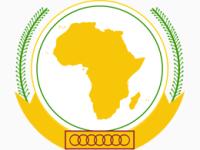
When African leaders discuss economic growth in Africa at this week’s African Union Summit, their options will be constrained by the growing AIDS epidemic and slow progress on reaching the Millennium Development Goals (MDG). For example, over the years we have seen agriculture output being impacted by people unable to till their fields or having to sell their land to take care of themselves and their families.
Let AIDS not be an obstacle but let the AIDS response provide an opportunity to transform the continent.
Michel Sidibé, executive director of UNAIDS
But it can be different. At the beginning of this year I visited Khayelitsha, a township in South Africa where I met Thobani, who was cured of TB and has access to AIDS treatment. Now he is able to take care of his son and contribute to his community. There are nearly 4 million people like Thobani, people who are vital to economic growth in Africa and elsewhere, thanks to organizations such as the Global Fund and the United States President’s PEPFAR initiative, which support 3,000 new patients to start AIDS treatment every day..
There are 22 million people living with HIV in Africa. For every two people who start on antiretroviral treatment, five are newly infected with HIV. This means the number of people in need of treatment will always increase.
Therefore we need to break the trajectory of the epidemic by stopping new HIV infections. This means focusing on prevention.
We also need to make treatment more affordable and ensure sustainable access to quality medicines in Africa. The demand is high, as nearly 80% of the 4 million people on treatment globally live in Africa, but 80% of the drugs distributed in Africa come from abroad. The waiting line for AIDS treatment is growing exponentially. Add to this the other top killers in Africa like TB and malaria and the treatment bill is unsustainable.
The drugs are expensive, and they do not work for ever. Patients will, after a period of time, need to move from first-line treatment for AIDS which today costs $92 per patient per year (well out of reach of people living on two dollars a day) to second-line treatment which costs more than $1,000 for the AIDS drugs alone. In Africa, less than 4% of patients are on second-line therapy, which is far below what effective treatment would require. Again unsustainable.
Africans will need these medicines for a long time. They need many others, as well. Most of these drugs, however, are not produced in Africa for lack of stringent quality standards and manufacturing capacity. Demand for AIDS treatment should become an opportunity for Africa to reform its pharmaceutical practices. Too often, drugs made in Africa are spurious or low quality. What Africa needs is a single African Drug Agency, similar to the European Medicines Agency, which regulates the pharmaceutical sector in Europe.
What will this achieve? First, the quality of medicines will be guaranteed across the continent. The agency should have the power and independence to enforce high quality international standards. This will help close down the market for spurious drugs. Second, manufacturers will not need to run from country to country to get their products approved. Third, this will integrate the African market to attract private sector investments for manufacture of medicines within Africa just as we have seen in Latin America. Fourth, it will ensure that there is a level playing field for manufactures to compete and market products within Africa and beyond just as India and China are doing. Fifth, it can be a model for removing bottlenecks, not only for medicines, but for wider development that will contribute to an AIDS+MDG movement in Africa. And all of these efforts must work in the best interests of people in need.
This is a concrete step that African leaders can task the African Union to make. UNAIDS will mobilize the UN system, development partners, promote south to south cooperation, and engage with the private sector to support the establishment of the regulatory agency. In this economic crisis, African leaders have an opportunity for innovation, just as the G8 leaders have an obligation to fulfil their pledge made at Gleneagles to provide universal access to AIDS treatment by 2010.
Let AIDS not be an obstacle but let the AIDS response provide an opportunity to transform the continent.
Michel Sidibé
Executive Director, Joint United Nations Programme on HIV/AIDS (UNAIDS)

